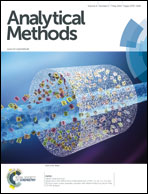A sensitive electrochemical biosensor for microRNA detection based on streptavidin–gold nanoparticles and enzymatic amplification
Abstract
An electrochemical method for microRNA (miRNA) detection has been proposed with a dual signal amplification strategy. The method relies on polymerase extension and a two-step signal amplification using streptavidin–gold nanoparticle biocomplexes and alkaline phosphatase. The target miRNA can hybridize with the capture DNA template, which can act as a primer and be extended along the template in the presence of DNA polymerase and dNTPs. A biotin group was introduced into the duplex by the incorporation of biotin-11-dUTP. Thus, biotinylated alkaline phosphatase would bind to the duplex using streptavidin–gold nanoparticles as linkers, which resulted in an amplified electrochemical signal. The electrochemical signal exhibited a linear correlation to the logarithm of miRNA concentration ranging from 100 fM to 1 nM, with a detection limit of 99.2 fM. The specificity of the method allowed single-nucleotide differences between miRNA family members to be discriminated. The established biosensor displayed an excellent analytical performance towards miRNA detection and might present a convenient tool for biomedical research and clinical diagnostic applications.


 Please wait while we load your content...
Please wait while we load your content...